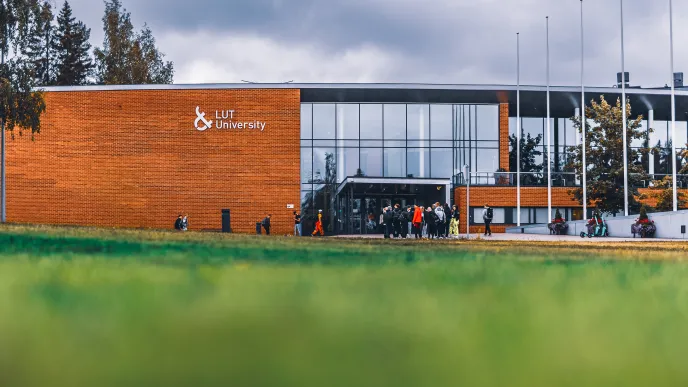When Jari Hämäläinen, vice rector for research and innovation, is asked to detail the goals of LUT’s research, he doesn't take long to reply.
“Our slogan is ‘Science with a purpose’, which captures the essence of what we do. People tend to need a purpose for whatever it is they're doing. At LUT, it’s easy to pinpoint that purpose: science doesn't exist for the sake of science – there's always a problem behind it that requires a solution,” Hämäläinen relates.
Hämäläinen has been a practical person throughout his career. After studying theoretical mathematics at the University of Jyväskylä, he transferred to applied mathematics and prepared his dissertation in a project funded by Valmet. The project modeled multiphase flows in paper machines. After defending his dissertation, Hämäläinen worked for an extensive period as a senior research scientist and research manager at VTT and Valmet.
“Working in industry, I could always start the day knowing full well why I was there. My job entailed examining what fluid dynamics expertise was needed to develop paper machines. In addition, I headed projects funded by Business Finland that also involved research institutes and universities around the globe,” Hämäläinen says.
Nevertheless, at the back of his mind, the idea of returning to the academic world started to take shape. Finally, in early 2004, Hämäläinen started as a professor at the University of Kuopio. In autumn 2010, he moved on to LUT to head the Centre of Computational Engineering and Integrated Design. In 2014, he was appointed vice rector.
In his current role, Hämäläinen is responsible for LUT's doctoral education, research platforms, and, as the chair of the tenure track committee, the recruitment of professors. Moreover, his daily work includes overseeing LUT's international research and impact assessments.
“International collaboration is an integral part of LUT's operation. For instance, we're using funding from the European Commission to build a joint European university called EULiST with nine other European universities. It aims to improve the quality and competitiveness of European universities through close collaboration and to strengthen the European value system and identity. I've been heavily involved in building this collaboration for the past three years,” says Hämäläinen.
LUT's strategy focuses on curbing climate change
The backdrop to LUT's research is a separately defined strategy that focuses on clean water, air, and energy, sustainable business, and a sustainable society. However, as Hämäläinen points out, researchers are free to choose their own research topics. How can academic freedom and the university's strategy be reconciled in practice?
“I could compare it to steering a large ship. We’re on a strategic course that defines the fields in which we can open new professorships. Meanwhile, academic freedom at the individual level guarantees that the professors and other researchers we recruit can choose the research topics they’re interested in,” Hämäläinen illustrates.
The strategic focus areas are usually reviewed at five-year intervals to determine which are still current and in which LUT can offer genuine expertise.
We keep track of global changes and want to be involved in major societal transitions.
“To be included in one of our focus areas, a research theme needs to be scientifically significant and sufficiently extensive to lead to innovations,” Hämäläinen underscores.
“In our previous strategy, one of the focus areas was the circular economy. In the current strategy, however, it has been divided into clean water and air, and clean air is also entwined with energy, as in carbon capture and recovery.”
Based on these strategic outlines, LUT has made decisions such as investing in separation technology laboratories, which have expanded from liquid separation to gas separation and, further, to energy by capturing carbon dioxide from the atmosphere and turning it into synthetic fuel.
“We keep track of global changes and want to be involved in major societal transitions. All our themes are closely connected to climate change and its mitigation. Related topics include renewable energy and energy investments, such as wind and solar energy, energy stored in hydrocarbon, the development of the electrical power system, different business models, and ultimately, we people and the entire society: how we accept and support different world-saving measures,” Hämäläinen says.
Multidisciplinary collaboration is the key to solving major problems
LUT's research does not aim for solutions that apply only to Finland – it aims for global solutions. That requires partnerships that transcend national boundaries. In fact, 62 percent of LUT's scientific publications are outcomes of international collaboration.
“Many of our projects are funded by the European Commission, and we often carry them out in collaboration with industry. The challenging issues that we investigate are often complex and involve solving more than one technological problem. We need experts from many fields to contribute,” Hämäläinen analyzes.
Hämäläinen points out that different disciplines should be seen as equally important in providing their own perspective on complex matters. Whereas engineering-focused disciplines examine problems through a technological lens, social sciences and business studies are just as necessary in analyzing society and ecological, economic, and social sustainability.
“For example, everyone wants to use renewable electricity, but how many of us want a wind turbine in our backyard? In any kind of societal transition, we always need to take people and societal practices into consideration,” Hämäläinen evaluates.
That takes us back full circle to the question we posed at the beginning: What’s at the heart of LUT’s research? If the objective of research is to solve grand societal problems, collaboration is the way to achieve it. Complex problems require complex solutions. That, in turn, requires bringing together experts from industry, different fields of science, and different countries.
“The world is full of universities that simply point out problems. We want to be involved in solving them. In close collaboration, we can identify each other’s strengths and bolster them. That's how we can solve the greatest problems of our time,” Hämäläinen concludes.
Jari Hämäläinen
- Originally from the Mikkeli area.
- LUT's vice rector for research and innovation since 2014.
- Is well versed in the methodology of international university rankings and is constantly thinking about ways to help LUT improve its position.
- Has previously worked at the applied physics department of the University of Kuopio, where he established a paper physics research group. As the university merged with the University of Joensuu to from the new University of Eastern Finland, Hämäläinen was the first director of its physics and mathematics department.
- Was a senior research scientist at VTT and Valmet and a research manager at Valmet.
- Has published many books and scientific papers. Has developed 12 patents.
- Holds several positions of trust, such as membership in the executive committee of the European Council of Academies of Applied Sciences, Technologies and Engineering (Euro-CASE).
- Hobbies include restoring old log houses, spending time at his summer house, and French wines. Former athlete and musician who often accompanies Christmas carol sing-alongs on LUT's campuses in Lahti and Lappeenranta.
More information:









